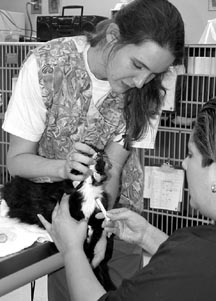
216
You cant get blood from a stone, and sometimes the adage seems also to apply to a cat. But often, that feat is a necessary one. The multitude of tests and assays that can be performed on a sample of your cats blood can tell your veterinarian much about her health status – its simply an invaluable method for evaluating her.
Remember the last time you gave a blood sample or donation? If you were lucky enough to have good veins and a competent phlebotomist (the person who takes the blood sample), you came away with no more than a small band aid-covered hole in your arm and a cup of orange juice. In a worst-case scenario, you received several holes and a few ugly bruises – despite the fact that you sat perfectly still for the procedure.
Imagine your cat undergoing the same. Obtaining a blood sample from a cat can be a difficult procedure. A cat that is comfortable being closely restrained, and a veterinarian or veterinary technician who is deft at venipuncture (the act of sticking a needle into the vein), can make the procedure look simple. But it is fraught with risks: that the cat will become fractious before a sample is obtained, that the vein will be difficult to puncture, that the blood will begin to clot within the needle and syringe.
Your veterinarian generally needs two types of blood samples from your cat: unclotted blood to smear in a thin layer on a microscope slide and then stained so that the individual blood cells – both red and white – can be counted and carefully examined for abnormalities. And serum, the yellow-tinged fluid left behind when blood clots, because it contains a multitude of measurable components, such as antibodies against specific viruses.
Usually, a single sample is taken from one of your cats veins, and the sample is divided into different blood tubes: Some contain anticoagulants to prevent clotting, others are designed to induce clotting and allow separation of the clot from the serum. For most routine blood tests, your veterinarian needs one to three milliliters (about one-quarter to one-half a teaspoon of blood).
The veins most commonly used to obtain a blood sample from a cat are the jugular veins and the medial saphenous veins, found on the inside of a cats back legs. The two jugular veins run down either side of a cats windpipe, just under the skin. They are relatively large – the diameter of a pencil – and easily located in most cats.
Every veterinary team has its own favorite method for holding a cat for jugular venipuncture. Most sit the cat on a table, her nose tilted toward the ceiling, while the phlebotomist stands in front of her and occludes the vein – holds it off so that it fills up – by placing a finger at the base of the throat. The needle is pointed upward, toward the cats head, and inserted under the skin and threaded into the vein. With good technique, a cooperative patient, and a bit of luck, a good sample quickly flows into the syringe. Afterward, light pressure is applied to the site where the needle punctured the skin to prevent bleeding beneath or through the skin.
For a cat that will not sit still for this procedure, the medial saphenous vein is the next best choice. The cat is held, gently but firmly, by the scruff of the neck and laid on her side. The holder uses her other hand to both hold back the cats upper rear leg and to occlude the vein in the lower rear leg by laying the little finger across it. The phlebotomist holds the lower leg still with one hand, and slides the needle under the skin and into the vein with the other. Because the medial saphenous vein is smaller than the jugular vein, it may be difficult to obtain a sufficient sample from it, or to obtain a sample that has not yet begun to clot.
Understandably, some cats tolerate neither of these procedures, and a sedative or anesthetic must be administered to calm or immobilize them so that a sample can be obtained.
How can you help your cat endure this process and ensure that your veterinarian obtains a good-quality sample? Understand that getting blood from a cat is often not easy. Know that your cat may be somewhat ruffled and bruised after the procedure, even if things go well. Allow your veterinarian to shave a bit of fur over your cats veins, especially if she has long or dark hair, both of which can make the task more difficult. And comply with a request to allow your veterinarian or her staff to perform the procedure without an audience (i.e., while you wait outside the exam room); most veterinary staff perform venipuncture best without a nervous owner involved.



